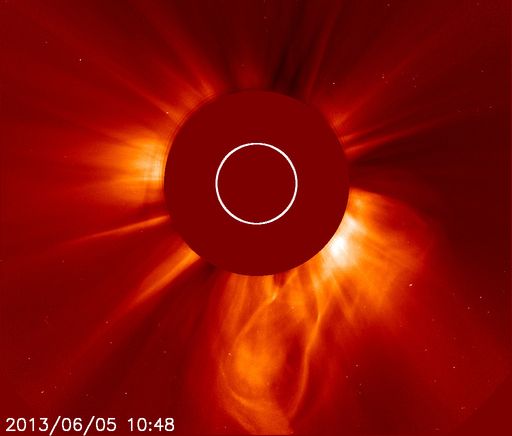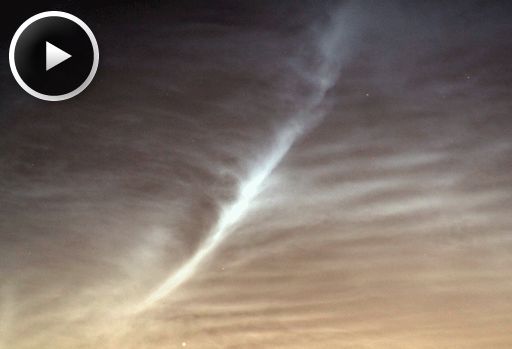SOLAR FLARE AND CME: Southern sunspot AR1762 erupted today, June 5th, producing a long-duration M1-class solar flare that peaked around 0900 UT. The explosion hurled a right coronal mass ejection (CME) into space, shown here in a coronagraph image from the Solar and Heliospheric Observatory:
Because the sunspot is approaching the sun's southwestern limb, the blast was not squarely Earth-directed. In fact, it might miss us altogether. Stay tuned for further analysis of the trajectory of the CME.
Meanwhile, more eruptions could be in the offing. AR1762 has a 'beta-gamma-delta' magnetic field that harbors energy for X-flares much stronger than the M1-class event that occured this morning. Solar flare alerts: text, voice.
NOCTILUCENT CLOUDS IN MOTION: The northern season for noctilucent clouds (NLCs) is underway. Since the middle of May, NASA's AIM spacecraft has been seeing banks of electric-blue NLCs circling Earth's north pole on a regular basis. Now, observers report that the clouds are spreading south. Pete Lawrence of Selsey UK photographed this apparition on June 3th (click to set the clouds in motion):
"I witnessed this fine NLC display on the morning of June 3rd," says Lawrence. "My location is 50.75N so it was amazing to see the clouds so far from the poles. As dawn approached, fingers of NLC spread until they were virtually overhead!"
Noctilucent clouds (NLCs) form near the top of Earth's polar atmosphere when water vapor from the planet below mixes with meteor debris from space. They appear during summer because that is when the mesosphere is coldest and most humid. This year, NLCs appeared early, more than a full month before the solstice, setting the stage for an unusually good NLC-watching season.
High latitude sky watchers should be alert for NLCs in the evenings ahead. In recent years they have been sighted as far south as Utah, Colorado, and Nebraska. Observing tips: Look west 30 to 60 minutes after sunset when the sun has dipped 6o to 16o below the horizon. If you see luminous blue-white tendrils spreading across the sky, you've probably spotted a noctilucent cloud.

![]()
Solar wind
speed: 503.7 km/sec
density: 1.4 protons/cm3
explanation | more data
Updated: Today at 1457 UT
![]()
X-ray Solar Flares
6-hr max: M1 0901 UT Jun05
24-hr: M1 0857 UT Jun05
explanation | more data
Updated: Today at: 1500 UT
![]()
![]()
![]()
Daily Sun: 05 Jun 13
![]()
![]()
Sunspot 1762 has a beta-gamma-delta magnetic field that harbors energy for X-class solar flares. Credit: SDO/HMI
![]()
![]()
![]()
Sunspot number: 59
What is the sunspot number?
Updated 05 Jun 2013
Spotless Days
Current Stretch: 0 days
2013 total: 0 days (0%)
2012 total: 0 days (0%)
2011 total: 2 days (<1%)
2010 total: 51 days (14%)
2009 total: 260 days (71%)
Since 2004: 821 days
Typical Solar Min: 486 days
Update 05 Jun 2013
The Radio Sun
10.7 cm flux: 110 sfu
explanation | more data
Updated 05 Jun 2013
![]()
![]()
![]()
Current Auroral Oval:
![]()
![]()
Switch to: Europe, USA, New Zealand, Antarctica
Credit: NOAA/POES
![]()
![]()
![]()
Planetary K-index
Now: Kp= 2 quiet
24-hr max: Kp= 3 quiet
explanation | more data
![]()
Interplanetary Mag. Field
Btotal: 3.5 nT
Bz: 1.1 nT south
explanation | more data
Updated: Today at 1457 UT
![]()
![]()
![]()
Coronal Holes: 04 Jun 13
![]()
![]()
Solar wind flowing from this coronal hole should hit Earth's magnetic field on June 8-9. Credit: SDO/AIA.






